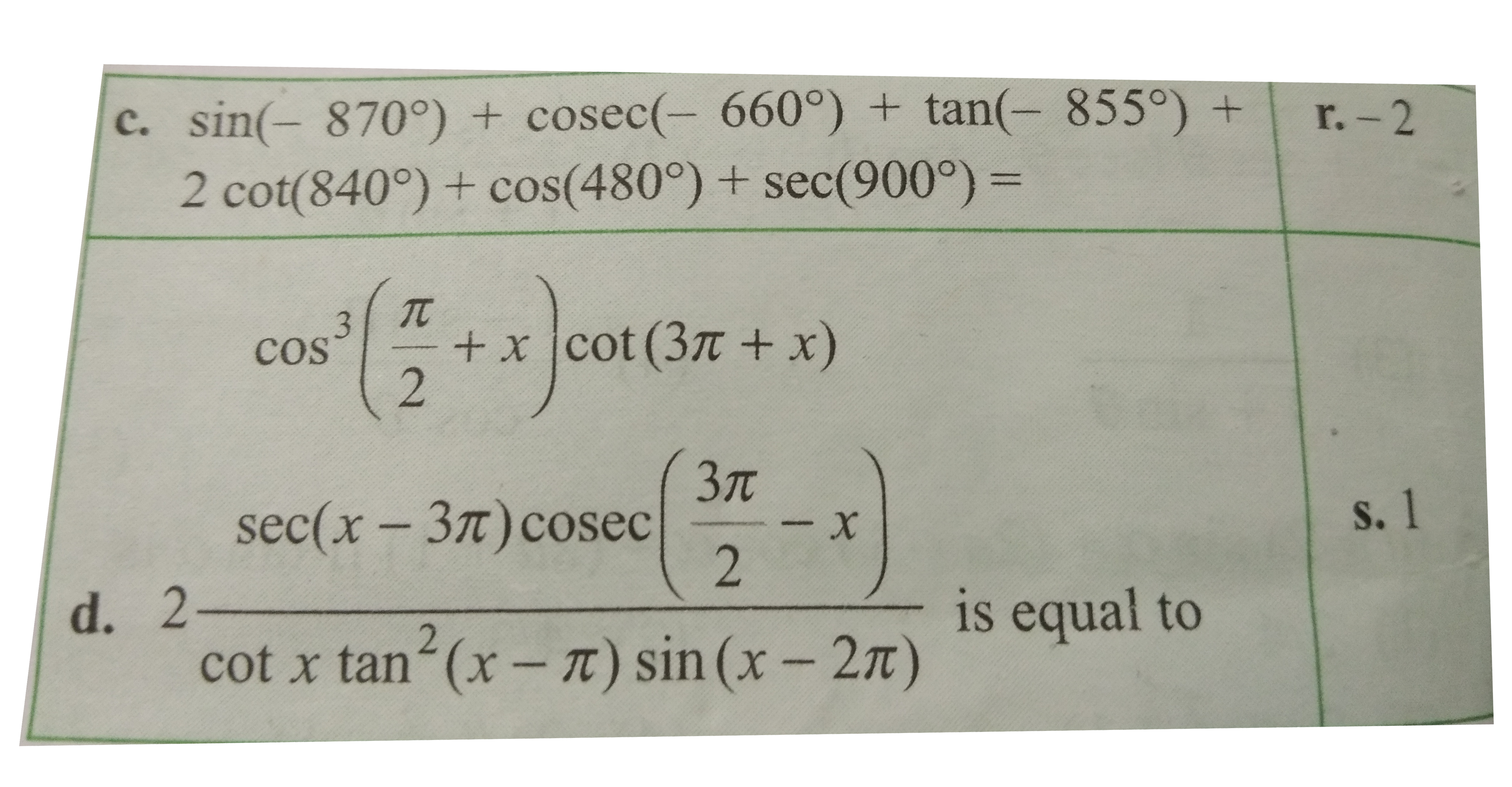Four numbers n1,n2,n3andn4 are given as n1=sin150−cos150,n2=cos930+sin930,n3=tan270−cot270,n4=cot1270+tan1270. n1<0 (b) n2<0 (c) n3<0 (d) n4<0Solution in Bengali
n1<0
n2<0
n3<0
n4<0
The correct Answer is:A, C, D
n1=sin15∘−cos15∘<−ve (cos15∘>sin15∘)
n2=cos93∘+sin93∘
=−sin3∘+cos3∘>0 (cos3∘>sin3∘)
n3=tan27∘−cot27∘<0 (tan27∘<cot27∘)
n4=cot127∘+tan127∘<0 (tan127∘,cot127∘<0).
Topper's Solved these Questions
- TRIGONOMETRIC FUNCTIONS BOOK - CENGAGE PUBLICATIONCHAPTER - TRIGONOMETRIC FUNCTIONS EXERCISE - Linked Comprehension Type
11 Videos
- TRIGONOMETRIC FUNCTIONS BOOK - CENGAGE PUBLICATIONCHAPTER - TRIGONOMETRIC FUNCTIONS EXERCISE - Matrix Match Type
3 Videos
- TRIGONOMETRIC FUNCTIONS BOOK - CENGAGE PUBLICATIONCHAPTER - TRIGONOMETRIC FUNCTIONS EXERCISE - Exercises
57 Videos
- TRIGONOMETRIC EQUATIONSBOOK - CENGAGE PUBLICATIONCHAPTER - TRIGONOMETRIC EQUATIONSEXERCISE - Archives (Numerical value type)
4 Videos
- TRIGONOMETRIC RATIOS AND TRANSFORMATION FORMULASBOOK - CENGAGE PUBLICATIONCHAPTER - TRIGONOMETRIC RATIOS AND TRANSFORMATION FORMULASEXERCISE - Archives (Numerical Value Type)
2 Videos
Similar Questions
Let us consider the equation cos^4x/a xa+sin4xb=1a+b,x∈[0,π2],a,b>0 the value of sin8xb3+cos8xa3 is
View Solution

View SolutionIf tanθ=3, then sinθ−cosθsinθ+cosθ is equal to
View SolutionThe number of all possible values of θ, where 0<θ<π, for which the system of equations (y+z)cos3θ=(xyz)sin3θ,xsin3θ=2cos3θy+2sin3θzand(xyz)sin3θ=(y+2z)cos3θ+ysin3θ have a solution (x0,y0,z0) wiith y0z0≠0 is
View SolutionThe maximum value of the expression 1sin2θ+3sinθcosθ+5cos2θ is………
View SolutionFour numbers n1,n2,n3andn4 are given as n1=sin150−cos150,n2=cos930+sin930,n3=tan270−cot270,n4=cot1270+tan1270. n1<0 (b) n2<0 (c) n3<0 (d) n4<0
View SolutionProve that the three lines from the origin O, with direction cosines l_1,m_1,n_1; l_2,m_2,n_2;l_3,m_3,n_3 are coplaner if |[l_1,m_1,n_1],[l_2,m_2,n_2],[l_3,m_3,n_3]|=0
View SolutionLet n1<n2<n3<n4<n5 be positive integers such that n1+n2+n3+n4+n5=20. Then the numbr of distinct arrangments (n1,n2,n3,n4,n5) is_________
View SolutionFour numbers n1,n2,n3andn4 are given as n1=sin15∘−cos15∘,n2=cos93∘+sin93∘,n3=tan27∘−cot27∘,n4=cot127∘+tan127∘,Then
View SolutionIf S1,S2 and S3 denote the sum of first n1,n2 and n3 terms respectively of an A.P. Then S1n1(n2−n3)+S2n2(n3−n1)+S3n3(n1−n2) equals :
View Solutionयदि n1<n2<n3<n4<n5 इस प्रकार के धनात्मक पूर्णाक है जिनके लिए n1+n2+n3+n4+n5 = 20 है। तब ऐसे विभिन्न विन्यासों की कुल संख्या है
View SolutionFour numbers n1,n2,n3andn4 are given as n1=sin150−cos150,n2=cos930+sin930,n3=tan270−cot270,n4=cot1270+tan1270. n1<0 (b) n2<0 (c) n3<0 (d) n4<0
View SolutionLet n1<n2<n3<n4<n5 be positive integers such that n1+n2+n3+n4+n5=20. then the number of distinct arrangements n1,n2,n3,n4,n5 is
View SolutionIf n_1 lt n_2 lt n_3 lt n_4 lt n_5 There are positive integers of this type for which n_1 +n_2 + n_3+n_4 +n_5=20 is . Then such distinct arrangements (n_1 , n_2 , n_3 , n_4 ,n_5) Is the total number of
View SolutionConsider the set A={3,4,5} and the number of null relations, identity relation, universal relations,reflexive relation on A are respectively n1,n2,n3,n4,Then the value of n1+n2+n3+n4 is equal to
View SolutionWhich of the follawing transition will have minimum wavelength? n4→n1, n2→n1, n4→n2, n3→n1
View Solution
